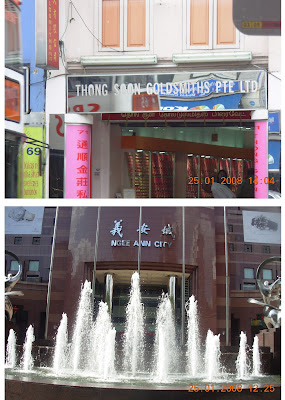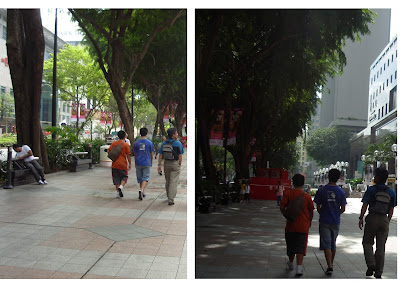chronicles of an igorot in australia. a photoblog in parts, this is intended as a diary, travelogue, memoir, journal, palimpsest, igorot blog, accounts of misadventures, running battles or whatever it turns out to be. there might be souls out there with common interests. do post a comment.
Monday 26 January 2009
Wednesday 7 January 2009
yearning for home in the range
The trip to Blackbutt turned out to be a rather pleasant sightsee of three towns. Although the job is in Blackbutt, we were booked accomodations in Nanango a further 35kms (30 mins drive) away. And on the way to nanango is the town of Yarraman, located at the junction of the D'Aguilar and New England Highways. Yarraman is a terminus of the New England Highway and also of the Brisbane Valley Heritage Trail (currently under construction).
I spent a total of three wonderful days in the area. As mentioned, this region is in the south burnett council, located on top of Australia's Great Dividing Range two hours drive nw of Brisbane. It is home to the State's biggest vineyards. More than 20 wineries and cellar doors, support its claim of Queensland's largest wine region. It is also home to two of Queensland's biggest inland waterways (a lake and a dam), the Jurassic-era Bunya Mountains and some of the prettiest agricultural country anywhere in oz. The timber towns of Blackbutt, yarraman and Nanango are located on top of the Blackbutt Range. They have a combined population of around 7,200 residents. Localities near these towns include Benarkin, Taromeo, Old Esk Road, Crows Nest Road and Nukku. The massive Tarong Power Station and Meandu Coal Mine are located 16km to the south of Nanango. The 11,700 hectares (about 25,000 acres) Bunya Mountains National Park is also adjacent to the shire.
These country towns have a friendly, relaxed and informal atmospheres. They have a low-humidity mountain climate of cool summers and brisk winters. The features include attractions that reflect historical connections with timber-felling, farming and mining. The towns are surrounded by a mixture of majestically tall eucalypt forests and hoop pine State Forests while the western regions lead into typical picturesque South Burnett grazing country. The areas have abundant wildlife and is popular with bushwalkers, campers and naturalists. In addition, the skies are insulated from urban light making them very popular with both amateur and professional astronomers.
Proof of this was one evening in Nanango when i opened my motel window to let some cool air in.
Proof of this was one evening in Nanango when i opened my motel window to let some cool air in.
I must have hit my head on the window frame, because when i came to, i was on terra firma - supine on the hard cold concrete cement.
I looked up and started seeing stars- but these were real stars! up there in the firmament.
It was almost like when you're lounging in a pool in mainit - in the nightime after a long day, half-floating and with your head laying on the poolside - and you can look at all those distant constellations in the sky, that paul simon can only sing about, and city dwellers like him and me can only dream about.
an older style house (nanango) next to my motel.
The area was first settled by Europeans in 1840s. Blackbutt was named for the eucalyptus piluralis tree which is native to the area. The name Nanango has evolved from "Nunangi". The original settlement near the big waterhole was called Noogoonida by the aborigines. It means place where the waters gather together - a large lagoon or lake). Yarraman itself means "wild horse". The population of the area only really began to boom in the very late 1800s when gold was discovered at several locations around Blackbutt and Benarkin precipitating a population boom. This was accelerated again when Yarraman became the terminus railhead for the Brisbane Valley Line. The early 1970s with the development of the Tarong Power Station led to a third population explosion. The south burnett relies mainly on timber, agriculture and tourism industries. The rich soils around support many rural industries including Forestry Department hoop pine plantations, horticultural farms, avocado and olive tree farming, flower growing and grazing. Nanango's principal industries are power generating and coal mining, agriculture, beef and pork production, dairying and milk processing, timber growing and milling, small crops, natural medicine, art and craftwork and tourism.
.JPG)
The area was first settled by Europeans in 1840s. Blackbutt was named for the eucalyptus piluralis tree which is native to the area. The name Nanango has evolved from "Nunangi". The original settlement near the big waterhole was called Noogoonida by the aborigines. It means place where the waters gather together - a large lagoon or lake). Yarraman itself means "wild horse". The population of the area only really began to boom in the very late 1800s when gold was discovered at several locations around Blackbutt and Benarkin precipitating a population boom. This was accelerated again when Yarraman became the terminus railhead for the Brisbane Valley Line. The early 1970s with the development of the Tarong Power Station led to a third population explosion. The south burnett relies mainly on timber, agriculture and tourism industries. The rich soils around support many rural industries including Forestry Department hoop pine plantations, horticultural farms, avocado and olive tree farming, flower growing and grazing. Nanango's principal industries are power generating and coal mining, agriculture, beef and pork production, dairying and milk processing, timber growing and milling, small crops, natural medicine, art and craftwork and tourism.
The Bunya Mountains, the overwhelming majority of which lies within the South Burnett, are an isolated section of the Great Dividing Range which rise abruptly from the surrounding countryside to elevations of 1100m at Mounts Mowbullan and Kiangarow (sounds like mainit names). I didn't venture there on this trip, but did spend a day & night up there a few years ago. The views are spectacular but the nights can be cool - even in summer - . The area contains the largest natural Bunya pine forest in the world along with a number of unique features such as natural grassland 'balds' (themselves composed of rare grass species) and both wet and dry rainforests. The Mountains are home to many species of Australian native birds including brilliantly-coloured king parrots and crimson rosellas, along with large numbers of rednecked wallabies, swamp wallabies and pademelons. Mountain possums can also be seen at night. Many native animals also wander freely around the picnic areas - but tourists are asked not to feed them (it's bad for wild animals to become dependent on humans).
as an aside:
The Bunya Mountains were formed in the Jurassic era and until the arrival of Europeans, they played a significant role in Aboriginal culture. Every three years tribes from throughout south-east Queensland would trek to the Mountains (often over a distance of several hundred miles) for special ceremonies, feasting, hunting and corroborees.
Timber cutters arrived in the region in the 1860s and began to establish sawmills to harvest the Bunya pines. However - once the uniqueness of the area began to be appreciated - public agitation for preservation of the Mountains quickly grew. In 1908 the Queensland State Government gazetted 9,303 ha as the Bunya Mountains National Park (the second declared national park ion the state). This was later extended to 11,700 ha - partly by land donations from locals who also wished to see this unique part of Australia preserved for future generations to enjoy. It's now proposed to extend the Park by a further 40% to further protect its fragile ecosystems.
Timber cutters arrived in the region in the 1860s and began to establish sawmills to harvest the Bunya pines. However - once the uniqueness of the area began to be appreciated - public agitation for preservation of the Mountains quickly grew. In 1908 the Queensland State Government gazetted 9,303 ha as the Bunya Mountains National Park (the second declared national park ion the state). This was later extended to 11,700 ha - partly by land donations from locals who also wished to see this unique part of Australia preserved for future generations to enjoy. It's now proposed to extend the Park by a further 40% to further protect its fragile ecosystems.
All access routes to the Mountains are very steep and all roads within the National Park are narrow, so caravans and trailers are not encouraged.
On that magical trip up here a few years ago, i enjoyed lighting a campfire in the chill mountain air and toasting marshmallows. we also baked pizza in a wood-fired oven. in the daytime we mingled with kangaroos feeding them from our hands. beautiful rossellas also visited at meal time perching on our head, shoulders and arms looking for seeds. one evening a badly wounded possum was a guest at our outdoor dinner table. these 'wildlife' are all friendly and quite trusting of humans once they learn that we mean them no harm.
I suppose i mention this aside, in the hope that such an eco-tourism system can be established in the homeland someday.
If it can be done in aboriginal australia's great dividing range, then it can be done in the Igorot gran cordillera central!
ps
i did do a bit of sightseeing but my camera had some battery problems (of the made in china type) so didn't really get more scenic photos. there's always next time.
and also did see the sights of the inside of nanango hotel (pub) - twice! what more can i say?
oh - happy new year!!!
Subscribe to:
Posts (Atom)



